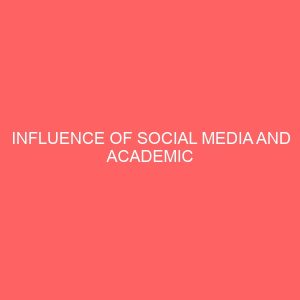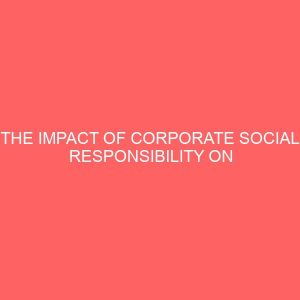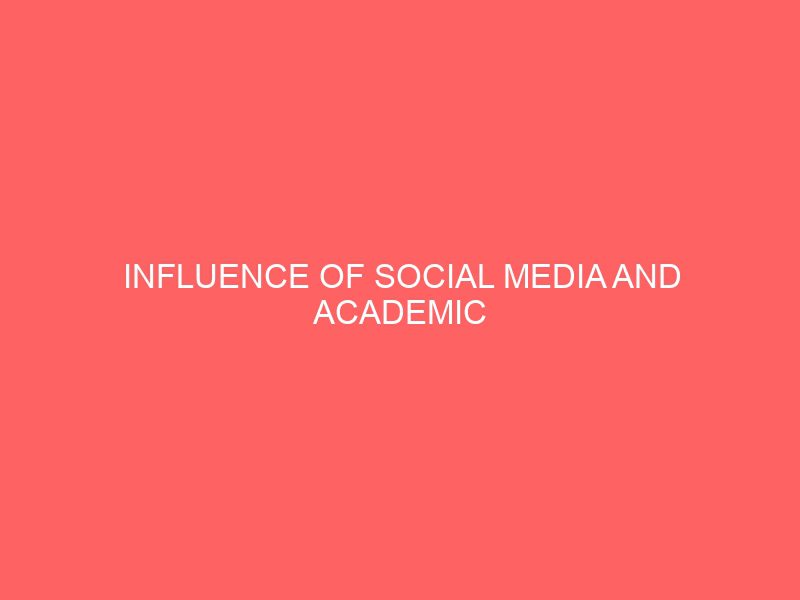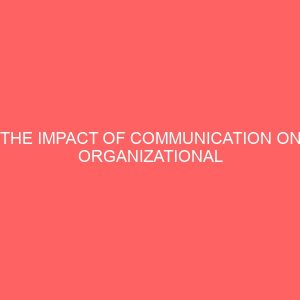Description
CHAPTER ONE
INTRODUCTION
1.1 BACKGROUND TO THE STUDY
The world is today celebrating the improvements in communication technology which has broadened the scope of communication through Information and Communication Technologies (ICTs). Modern Technology in communication no doubt has turned the entire world into a Global village. But as it is, technology like two sides of a coin, bring with it both negative and positive sides. It helps people to be better informed, enlightened, and keeping abreast with world developments. Technology exposes mankind to a better way of doing things. Social networking sites include: Twitter, Yahoo Messenger, Facebook Messenger, Blackberry Messenger (BBM), Whats app messenger, 2go messenger, Skype, Google talk, Google Messenger, iPhone and Androids. These networking sites are used by most people to interact with old and new friends, physical or internet friends ( Asemah and Edegoh, 2012).
The world has been changed rapidly by the evolution of technology; this has resulted into the use of technology as the best medium to explore the wide area of knowledge.
The evolution of internet technology has led to its use as the best medium for communication. Whereby, two-third of the worlds internet population visits social networking or blogging sites, thus serving as a communication and connection tool. Social networking sites (SNSs) are online Communities of Internet users who want to communicate with other users about areas of mutual interest, whether from a personal, business or academic perspective? (William ,Boyd, Densten, Chin, Diamond & Morgenthaler 2009).
The millions of social networking sites have transformed the thought of global village into a reality whereby billions of people communicate through social networking sites. Numerous benefits have been obtained through distant communication through the use of social networking sites.
Academic excellence or achievement plays an important role in an individual placement, be it in the academic institutions or job placement. Due to this, many people are concerned with the ways they can enhance their academic achievement. The emphasis on academic excellence which is also prevalent worldwide has encouraged many studies about the conditions promoting it. The role of academic achievement as one of the predictors of ones life success and also in the aspect of academic placement in schools to higher institutions as well as the level of employability in ones career is inevitable (Kyoshaba, 2009).
Academic performance, which is measured by the examination results, is one of the major goals of a school. Hoyle (1986) argued that schools are established with the aim of imparting knowledge and skills to those who go through them and behind all this is the idea of enhancing good academic performance.
Academic performance or achievement is the outcome of education, the extent to which a student, teacher or institution has achieved their educational goals. Academic performance is commonly measured by examinations or continuous assessment but there is no general agreement on how it is best tested or which aspects are most important, procedural knowledge such as skills or declarative knowledge such as facts (Annie, Howard & Mildred, 1996). A direct relationship exists between Social media usage and the academic performance of students in polytechnics. However, the darker side within technological evolution has resulted in dilemmas such as the setback of real values of life especially among students who form the majority of users interacting through the use of social networking sites. Online social networking sites focus on building and reflecting social associations among people who share interests and or activities. With so many social networking sites displayed on the internet, students are tempted to abandon their homework and reading times in preference for chatting online with friends. Many students are now addicted to the online rave of the moment, with Facebook, Twitter etc.
Today most youths and students possess Facebook accounts. The reason most of them perform badly in school might not be far- fetched. While many minds might be quick to blame the poor quality of teachers, they might have to think even harder, if they have not heard of the Facebook frenzy (Oche & Aminu .2010). Olubiyi (2012) noted that these days students are so engrossed in the social media that they are almost 24 hours online. Even in classrooms and lecture theatres, it has been observed that some students are always busy pinging, 2going or Facebooking, while lectures are on. Times that ought be channeled towards learning, academic research and innovating have been crushed by the passion for meeting new friends online, and most times busy discussing trivial issues. Hence most students academics suffer setback as a result of distraction from the social media. In (Obi, Bulus, Adamu & Salaat 2012), it was observed that the use of these sites also affects students use of English and grammar. The students are used to short forms of writing words in their chat rooms; they forget and use the same in the classrooms. They use things like 4 in place of for, U in place of You, D in place of The etc. and this could affect their class assessment.
Social networking sites although has been recognized as an important resource for education today, studies however shows that students use social networking sites such as Facebook for fun, to kill time, to meet existing friends or to make new ones (Ellison, Steinfield, and Lampe 2007). Although it has been put forward that students spends much time on participating in social networking activities, with many students blaming the various social networking sites for their steady decrease in grade point averages (Kimberly, Jeong and Lee, 2009), it also shows that only few students are aware of the academic and professional networking opportunities the sites offered.
According to Kuppuswamy and Shankar (2010), Social network websites grab attention of the students and then diverts it towards non-educational and inappropriate actions including useless chatting. Whereas on the other hand, (Liccardi, Ounnas, Massey, Kinnunen, Midy, & Sakar. 2007) reviewed that the students are socially connected with each other for sharing their daily learning experiences and do conversation on several topics.
Tinto (1997) argued that extracurricular activities and academic activities are not enough to satisfy some student those who are suffered by social networking isolation. This shows that social networks are beneficial for the students as it contributes in their learning experiences as well as in their academic life. Trusov, Bucklin, & Pauwels (2009) noted that the Internet is no doubt evolution of technology but specifically social networks are extremely unsafe for teenagers, social networks become hugely common and well-known in past few years. According to Cain (2009) social network websites provide ease of connecting people to one another; free of cost and after connecting one can post news, informative material and other things including videos and pictures etc. Wiley and Sisson (2006) argued that the previous studies have found that more than 90% of tertiary school students use social networks. In the same way Ellison et al (2007) stated that the students use social networking websites approximately 30 minutes throughout the day as a part of their daily routine life. This statement shows the importance of social networking websites in students life. Lenhart and Madden (2007) revealed through a survey that students strongly recommend social networking websites to stay in touch with friends to keep informed and aware.
Social information processing theory is an interpersonal communication theory which suggests that online interpersonal relationship development might require more time to develop than face-to-face relationships, but when developed, it has the same influence as face-to-face communication. This means, the more students use social media, the more they influence their disposition to studies, given the fact that friends from social media will begin to exert influence on each other.
SOCIAL NETWORK
Early 1990s, chat rooms and bulletin boards were forms of Social Networking in a way they help people to connect with others and share interest. A little cater; dating sites hooked those looking for partners and classmates.
In the early 20s, a site called Friendster was setup where people invited their Friend and their friends also invited others.
The site was popular for a while, but suffered from technical difficulties and fake profiles and began to lose members. In 1999, my space took over but became popular in 2003. Its roots are a bit muddy because it received financial and logistical support from another company called the E-Universe but Tom Anderson and Chris DE Wolfe are given credit for much of the innovation and success of the site, which built up to one hundred and fifteen million users worldwide. Members post BIOS, photos, blogs, videos, and other things that strike their fancy.
Some television programmers had started producing programmes to air on MySpace in 2005; Rupert Murdoilis News Corporation, (Parent of Fox broadcasting) bought MySpace for five hundred and eighty million dollars ($580). A competitor to MySpace is Facebook which started in about 2004 by Mark Zuckerberg while he was a student at Harvard and grew rapidly in 2007. At first Facebook was solely for college and high school students but Mark opened it to everyone and like MySpace, it encourages all types of member postings. There are also smaller social networks like 2go, YouTube and BlackBerry chat for people to have access to.
BRIEF HISTORY OF THE IBARAPA POLYTECHNIC, ERUWA.
The Ibarapa Polytechnic, Eruwa, was established as a satellite campus of The Polytechnic, Ibadan on Tuesday 19th Jan. 1982 and later converted into an autonomous Polytechnic in 2014.
The school now offers courses leading to the award of Ordinary National Diploma (OND) and Higher National Diploma (HND). The primary function of The Ibarapa Polytechnic, Eruwa is to provide training for the students and development of techniques in Applied Science, Engineering, Environmental Studies, Communication and Management Studies.
1.2 STATEMENT OF PROBLEM
The world today is a global market in which the internet is the most important sort of information. Since the advent of social media sites in the 1990s, it is assumed in some quarters that the academic performance of students is facing a lot of neglect and challenges. The educational system in Nigeria is faced with so many challenges which have certainly brought about a rapidly decline in the quality of education. There is a deviation, distraction and divided attention between social networking activities and their academic work. It is observed that students devote more attention to social media than they do to their studies.
Student’s addictiveness to social networks, students frequency of exposure to social network, social media network that the students are more exposed to and the influence of social media as a medium of interaction between students has been part of discussion in recent times and which have imparted on their academic performance. Instead of students reading their books, they spend their time chatting and making friends via the social media and this might definitely have influence on their academic performance, because when you do not read, there is no way you can perform well academically. It is a common sight to see a student chatting in sensitive and highly organized places like church, mosque and lecture venues. Some are so carried away that even as they are walking along the high way, they keep chatting.
The manufacturing and distribution of equally sophisticated cellular phones has complicated the situation, as students no longer need to visit a cybercafé before they send and receive messages. Attention has been shifted from visible to invisible friends, while important ventures like study and writing might be affected in the process. This phenomenon has become a source of worry to many who believe in knowledge and skill acquisition.
In recent times social media have been a major stay in the minds of students and the world at large thereby causing a lot of drastic measure by students, teacher and even educational administrators at large. It is therefore of great importance to explore some of the trending issues facing students academic performance as a result of social media. Students at all levels of learning now have divided attention to studies, as a result of available opportunities to be harnessed from social media. Whether these opportunities promote studies is a question that needs to be answered. Thus, the problem this study investigates is the influence of social media networks on the academic performance of the students in The Ibarapa Polytechnic, Eruwa.
1.3 PURPOSE OF THE STUDY
The purpose of this study generally is to examine the influence of Social Media on the Academic Performance of ( A Study of The Ibarapa Polytechnic, Eruwa).
Specifically, the study seeks;
i. To examine the level of students addictiveness to social media and the influence on their academic performance.
ii. To determine the social media network that has influence on students academic performance.
iii. To ascertain how the use of social media has influenced the academic performance of the students in The Ibarapa Polytechnic, Eruwa.
iv. To ascertain how age has influence on students usage of social media networks.
1.4 RESEARCH QUESTIONS
The following research questions were raised;
i. To what extent would students addictiveness to social networks influence their academic performance?
ii. Does the social media networks that the students are exposed to influence their academic performance?
iii. How has the use of social media influence the academic performance of the students in The Ibarapa Polytechnic, Eruwa?
iv. Is there gender difference in the student’s usage of social media networks?
v. In what way does a social medium influence younger and older students?
1.5 RESEARCH HYPOTHESES
The following hypotheses are generated by the researcher and were tested in this study:
i. Students addictiveness to social networks and its significant influence on their academic performance.
ii. Student’s exposure to social media networks has no significant influence on students academic performance.
iii. Use of social media do no significantly influence on the academic performance of the students in The Ibarapa Polytechnic. Eruwa.
iv. There is no significant difference between male and female student usage of social media networks.
v. Age does not have significant influence on the use of social media.
1.6 SIGNIFICANCE OF THE STUDY
This study is significant to the teachers, parents and students. This study will help the teachers of the school to know the influence that social media has on their students, so as to assist them to enlighten and create awareness to the students on the possible influence it has on them.
The study is of significant to parents in the sense that they will know the possible effects these social media usage has on their children, so as to serve as watch-dog to their children on the usage of the social networking site.
The study will enable the students of the senior level so that they will be aware that, apart from the social benefits of this social networking site, using the sites more than necessary will pose possible dangers to their health. It will be relevant in assisting students in understanding the diversity of social media. It will provide relevance material for students and other researchers undertaking similar research.
The study will help researchers with more information on the Influence of social media on students academic performance.
1.7 SCOPE OF THE STUDY
The focus of this research work is to primarily study the Influence of social media on the academic performance of students. The study will comprise students in The Ibarapa Polytechnic, Eruwa.
1.8 OPERATIONAL DEFINITION OF TERMS
As words may mean differently in different contexts, the following definitions are given as the words used as intended to be understood for the purpose of this study.
i. Social Media: They are forms of electronic communication which facilitate interactive base on certain interests. Social media include web and mobile technology.
ii. Social Networking Sites: A website where people put information about them and can send to others.
iii. Social Networking: The use of internet to make information about yourself available to other people especially people you share an interest with to send messages to them.
iv. Media: Are all those media technologies that are intended to reach a large audience by mass communication. They are messages communicated through a mass medium to a number of people.
v. Academic: It is concerned with Studying from books as opposed by a practical work.
vi. Students: Someone who is Studying in a School, Someone who is very interested in a particular subject.
vii. Computer: A computer is a machine that receives or stores or process data quickly according to a stored program.
viii. Tweets: A short message posted on Twitter (a micro blog).
ix. ICT: Information and Communication Technology.







